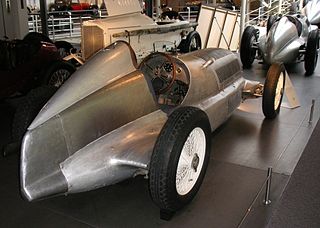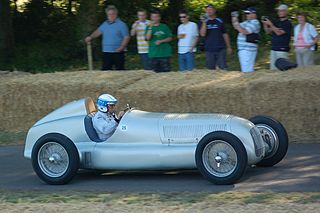This article needs additional citations for verification .(November 2016) |
Karl Rudolf Heydel born (1911 in Leipzig; died 4 February 1936 in Monza), [1] Italy, was a German racing driver.
Contents

This article needs additional citations for verification .(November 2016) |
Karl Rudolf Heydel born (1911 in Leipzig; died 4 February 1936 in Monza), [1] Italy, was a German racing driver.

Heydel worked as a test driver in the research department of the Zwickau-Horch- works. [1] He was a protégé of Auto Union-Works team driver Hans Stuck. In November 1935, the Auto Union racing department with race director Karl Feuereissen tested some drivers on the Nordschleife of the Nürburgring. Karl Rudolf Heydel, Ernst von Delius and Rudolf Hasse were selected to drive for Auto Union in the 1936 European Championship alongside the established drivers Bernd Rosemeyer and Hans Stuck.
In February 1936, the three new drivers had to carry out tests on the nearly seven-kilometer high-speed circuit at the Italian Autodromo Nazionale Monza. On the morning of 4 February Heydel started his first test in the Auto Union Type C racing car. On his third lap, the inexperienced driver lost control in the Curva del Vialone, situated at the start of what is today the Variante Ascari, and crashed into the barriers. The impact caused a fuel leak, which ignited immediately setting the vehicle ablaze. Heydel was killed on the spot.

Tazio Giorgio Nuvolari was an Italian racing driver. He first raced motorcycles and then concentrated on sports cars and single-seaters. A resident of Mantua, he was known as "Il Mantovano Volante" and nicknamed "Nivola". His victories—72 major races, 150 in all—included 24 Grands Prix, five Coppa Cianos, two Mille Miglias, two Targa Florios, two RAC Tourist Trophies, a Le Mans 24-hour race, and a European Championship in Grand Prix racing. Ferdinand Porsche called him "the greatest driver of the past, the present, and the future".

The Automobil-Verkehrs- und Übungsstraße, known as AVUS, is a public road in Berlin, Germany. Opened in 1921, it was also used as a motor racing circuit until 1998. Today, the AVUS forms the northern part of the Bundesautobahn 115.
Grand Prix motor racing, a form of motorsport competition, has its roots in organised automobile racing that began in France as early as 1894. It quickly evolved from simple road races from one town to the next, to endurance tests for car and driver. Innovation and the drive of competition soon saw speeds exceeding 100 miles per hour (160 km/h), but because early races took place on open roads, accidents occurred frequently, resulting in deaths both of drivers and of spectators. A common abbreviation used for Grand Prix racing is "GP" or "GP racing".

Auto Union AG, was an amalgamation of four German automobile manufacturers, founded in 1932 and established in 1936 in Chemnitz, Saxony. It is the immediate predecessor of Audi as it is known today.

Silver Arrows is a nickname typically given to silver racing cars with a significant connection to a German car manufacturer. It was originally given by the press to Germany's dominant Mercedes-Benz and Auto Union Grand Prix motor racing cars between 1934 and 1939. The name was later applied to the Mercedes-Benz Formula One and sports cars in 1954 and 1955, then to the Sauber Group C prototype racing sports cars that raced at Le Mans in the late 1980s as well as the McLaren-Mercedes Formula One cars of the late 1990s and 2000s, and is currently applied to the Mercedes-AMG Petronas F1 cars from 2010 to present.

Bernd Rosemeyer was a German racing driver and speed record holder. He is considered one of the greatest racing drivers of all time. Though he was not a member of the Nazi party, he was made a member of the SS for propaganda purposes and held the rank of Hauptsturmführer.

Otto Wilhelm Rudolf Caracciola was a racing driver from Remagen, Germany. He won the European Drivers' Championship, the pre-1950 equivalent of the modern Formula One World Championship, an unsurpassed three times. He also won the European Hillclimbing Championship three times – twice in sports cars, and once in Grand Prix cars. Caracciola raced for Mercedes-Benz during their original dominating Silver Arrows period, named after the silver colour of the cars, and set speed records for the firm. He was affectionately dubbed Caratsch by the German public, and was known by the title of Regenmeister, or "Rainmaster", for his prowess in wet conditions.

Hans Erich Karl Josef Stuck was a German motor racing driver. Both his son Hans-Joachim Stuck and his grandsons Johannes and Ferdinand Stuck became race drivers.

Horch was a car brand manufacturer, founded in Germany by August Horch & Cie at the beginning of the 20th century.

The 1936 Grand Prix season was the third year of the 750 kg Formula. The next iteration of the Mercedes-Benz did not prove successful and the team withdrew during the season to instead prepare for the next one. It therefore fell to the resurgent Auto Union team to dominate the racing. In particular, it was their young, new superstar, Bernd Rosemeyer, who mastered the tricky car and who showed superlative skill in wet conditions. Rosemeyer easily won this season's European Championship by winning three of the four Grands Prix.
Georg "Schorsch" Meier was a German motorcycle racer famous for being the first foreign winner of the prestigious Senior TT, the Blue Riband race of the Isle of Man TT Races, in 1939 riding for the factory BMW team and the first motorcycle racer to lap a Grand Prix course at over 100 mph.

The 1935 Grand Prix season was the second year of the new 750 kg Formula. The success of the previous year encouraged the AIACR to reinitiate the European Championship. It was composed of the seven national Grands Prix and was won by Rudolf Caracciola, driving for the Mercedes-Benz team. The team dominated the season winning five of those Grand Épreuves, as well as four of the other major races of the season. However, in one of the great motor-races in sporting history, Tazio Nuvolari in a Scuderia Ferrari Alfa Romeo beat the combined numbers of the German teams in their home Grand Prix. The season also saw the arrival on the international stage of the bright young talent Bernd Rosemeyer in the Auto Union team.

The 1931 Grand Prix season was a watershed year, with the advent of the AIACR European Championship. After several years of Grand Prix racing in the doldrums with little technical development, 1931 saw new models come from all three main manufacturers: Bugatti, Maserati and Alfa Romeo.

The 1932 Grand Prix season marked the second year of the AIACR European Championship. It saw the debut of Alfa Romeo's sensational new Tipo B and with it, Tazio Nuvolari won the Championship driving for the Alfa Corse works team. The 40-year old Nuvolari won two of the three rounds and was second in the other. Still running to a Formula Libre rules for the cars, the regulations were revised to set the races to be between five and ten hours. However, all three national committees ran their races to the minimum time-limit.

The Grossglockner Races were hillclimbs for automobiles and motorcycles held in 1935, 1938 and 1939 on the Grossglockner High Alpine Road crossing the Central Eastern Alps in Austria.

The 1933 Grand Prix season was an intermediate year, as it would be the last season for the current AIACR regulations before a new weight-formula was introduced in 1934. As such, the European Championship was not held and the manufacturers held back on further developments of their existing models. Alfa Romeo, following an Italian government financial bailout and like Mercedes-Benz the previous year, had shut down its Alfa Corse works team. Scuderia Ferrari, their regular customer team took up the role of racing Alfa Romeos and a number of ex-works drivers moved across to join their ranks. They were not allowed, however, to buy the impressive Tipo B that had been so dominant in the previous season.
The 1934 Grand Prix season saw the advent of the new 750 kg Formula. In an effort to curb the danger of rising speeds, the AIACR imposed this upper weight limit that effectively outlawed the large capacity engines. The incumbent manufacturers Alfa Romeo, Maserati and Bugatti had been preparing their new models with varying success – the best of which was the Alfa Romeo Tipo B. However, it was the state-sponsored arrival of the two German teams, Mercedes-Benz and Auto Union, and their innovative and progressive cars that ignited a new, exciting era of motor racing.

The Auto Union Grand Prix racing cars types A to D were developed and built by a specialist racing department of Auto Union's Horch works in Zwickau, Germany, between 1933 and 1939, after the company bought a design by Dr. Ferdinand Porsche in 1933.

The Mercedes-Benz W25 was a Grand Prix racing car designed by Daimler-Benz AG for the 1934 Grand Prix season, in which new rules were introduced, and no championship was held. In 1935, the European Championship was resumed, and it was won by Rudolf Caracciola in a W25. In modified form, the W25 remained in use until 1937, when it was succeeded by the Mercedes-Benz W125.

August "Bubi" Momberger was a German racing driver and engineer, who competed in Grand Prix motor racing events for various manufacturers between 1926 and 1934. During the 1934 Grand Prix season – the first season of the infamous Silver Arrows period of German dominance of Grand Prix racing, that would last until the outbreak of WWII – he drove for the Auto Union Rennabteilung, and was the first driver of a Silver Arrows car to take a podium finish in a major race. During the season he took a further second-placed finish, and posted two fastest laps, but worsening arthritis and a deteriorating relationship with the Auto Union team manager forced him into retirement before the end of the year. Following his retirement from racing, Momberger returned to his engineering training and rose steadily through the ranks of the German automobile industry, eventually becoming technical director of the Borgward company's Goliath division in Bremen.